Cosmo Bedford Hotel, Bloomsbury Square, London, Friday morning, 1 September 2000
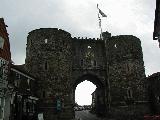
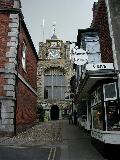
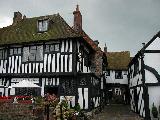 Wednesday morning we explored Rye on foot. The old former port is as picturesque as ever but badly needs to "pedestrianise" many of its old streets. Like most medieval towns it makes for confusing and stressful driving, and giving cars the complete run of the place rather ruins it for pedestrians, as well as marring its beauty. Only once did we find even a crossing vouchsafed to pedestrians. I had thought to revisit the Mermaid Inn (right), where we stayed when I was thirteen; but now it is just ludicrously overpriced--obviously with a deliberate intent to exclude riffraff like us, even (or especially) for lunch.
Wednesday morning we explored Rye on foot. The old former port is as picturesque as ever but badly needs to "pedestrianise" many of its old streets. Like most medieval towns it makes for confusing and stressful driving, and giving cars the complete run of the place rather ruins it for pedestrians, as well as marring its beauty. Only once did we find even a crossing vouchsafed to pedestrians. I had thought to revisit the Mermaid Inn (right), where we stayed when I was thirteen; but now it is just ludicrously overpriced--obviously with a deliberate intent to exclude riffraff like us, even (or especially) for lunch.
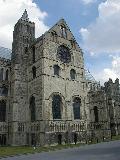 Thursday morning we visited the cathedral in Canterbury. It is a curiously split-level affair; at the front of the nave you go either upstairs to the choir or downstairs to a crypt that extends under the whole eastern half of the cathedral. Of course, we did both. The crypt contains a great deal of beautiful stonework of the Norman period, and some vestiges of later frescoes. In the center some of the massive arches of the Norman groined vault are filled in with delicate late-gothic traceries, for a wonderfully contrastive effect. Upstairs in the choir is also a lot of Norman work; and an effect of airy spaciousness, not usually associated with Norman work, is achieved through an eastern secondary pair of transepts (the south one shown left from the outside), since this secondary crossing is not interrupted or punctuated by any screen or anything.
Thursday morning we visited the cathedral in Canterbury. It is a curiously split-level affair; at the front of the nave you go either upstairs to the choir or downstairs to a crypt that extends under the whole eastern half of the cathedral. Of course, we did both. The crypt contains a great deal of beautiful stonework of the Norman period, and some vestiges of later frescoes. In the center some of the massive arches of the Norman groined vault are filled in with delicate late-gothic traceries, for a wonderfully contrastive effect. Upstairs in the choir is also a lot of Norman work; and an effect of airy spaciousness, not usually associated with Norman work, is achieved through an eastern secondary pair of transepts (the south one shown left from the outside), since this secondary crossing is not interrupted or punctuated by any screen or anything.
We eschewed the motorway in favor of the old Roman roadway between Canterbury and London, the same that Chaucer's pilgrims trod. Alas we did not catch sight of "Bob-up-and-down," the elusive town mentioned in the Manciple's prologue and hilariously hymned by G. K. Chesterton in The Coloured Lands.
Friday evening:

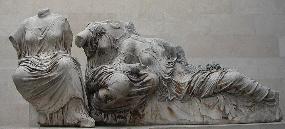 This morning we went to the British Museum at opening time to see the Elgin Marbles and a few other Greek antiquities before Stas had to depart yet again for an appointment in Tunbridge Wells, this time by train from Charing Cross. The Elgin Marbles (no longer so termed by the museum) are the cream of what survives of the original sculptural ornamentation of the Parthenon. The museum got them from Lord Elgin, who bought them off the Turks, who were hostile occupiers of Greece at the time. The museum insists that this was all legal at the time and that it is itself barred by law from repatriating the carvings. I wish this line of argument, still stinking from its recent employment in the Jewish gold scandal in Switzerland, all the success it deserves. (One must admit, however, that it was a good thing for these carvings to have been brought indoors out of the rain, as it meant that the air pollution of the next two centuries--though probably worse in London than in Athens for most of that time--was vastly less potent to corrode the marble.) Here we see some of the full-round carvings of the eastern pediment, above the temple's entrance; the missing center depicted the birth of Athena, the city's patron goddess and dedicatee of the temple. Speaking of pediments, I must say I laughed aloud at a recent news story in which the museum administration complained of being "mugged" by alleged sharp practice involving stone for one of the museum's own pediments.
This morning we went to the British Museum at opening time to see the Elgin Marbles and a few other Greek antiquities before Stas had to depart yet again for an appointment in Tunbridge Wells, this time by train from Charing Cross. The Elgin Marbles (no longer so termed by the museum) are the cream of what survives of the original sculptural ornamentation of the Parthenon. The museum got them from Lord Elgin, who bought them off the Turks, who were hostile occupiers of Greece at the time. The museum insists that this was all legal at the time and that it is itself barred by law from repatriating the carvings. I wish this line of argument, still stinking from its recent employment in the Jewish gold scandal in Switzerland, all the success it deserves. (One must admit, however, that it was a good thing for these carvings to have been brought indoors out of the rain, as it meant that the air pollution of the next two centuries--though probably worse in London than in Athens for most of that time--was vastly less potent to corrode the marble.) Here we see some of the full-round carvings of the eastern pediment, above the temple's entrance; the missing center depicted the birth of Athena, the city's patron goddess and dedicatee of the temple. Speaking of pediments, I must say I laughed aloud at a recent news story in which the museum administration complained of being "mugged" by alleged sharp practice involving stone for one of the museum's own pediments.

 These are panels from a frieze that would scarcely have been visible in situ. Note how the long evolutionary increase in equine size over the past forty or fifty million years, from the Eocene to the present, still has a substantial way to go. (The golden age of Greece was just an eyeblink ago in terms of such geologic time, of course, but selective breeding under domestication accelerates the evolutionary process enormously, which is why Darwin uses it as a starting point for his On the Origin of Species.) These horses are so small in relation to human stature that it's a wonder to see them ridden astride at all, and no wonder that ancient warriors are usually represented as fighting from chariots drawn by teams.
These are panels from a frieze that would scarcely have been visible in situ. Note how the long evolutionary increase in equine size over the past forty or fifty million years, from the Eocene to the present, still has a substantial way to go. (The golden age of Greece was just an eyeblink ago in terms of such geologic time, of course, but selective breeding under domestication accelerates the evolutionary process enormously, which is why Darwin uses it as a starting point for his On the Origin of Species.) These horses are so small in relation to human stature that it's a wonder to see them ridden astride at all, and no wonder that ancient warriors are usually represented as fighting from chariots drawn by teams.
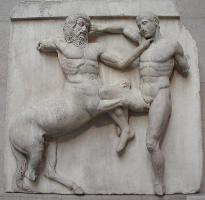 Metopes like this one would have been much more conspicuous, as well as being carved in much higher relief. Around the outside of the building, at the top, these alternated with triglyphs (the Doric order's homage to wooden beam ends, each resembling the Roman numeral III); they depict the mythic battle between the Lapiths and the Centaurs. Again one can see that the equine portions of the centaur's anatomy seem strangely small in relation to the human anatomy of both combatants.
Metopes like this one would have been much more conspicuous, as well as being carved in much higher relief. Around the outside of the building, at the top, these alternated with triglyphs (the Doric order's homage to wooden beam ends, each resembling the Roman numeral III); they depict the mythic battle between the Lapiths and the Centaurs. Again one can see that the equine portions of the centaur's anatomy seem strangely small in relation to the human anatomy of both combatants.

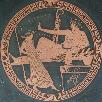 I had seen the Elgin marbles before, but the prospect of seeing the Parthenon itself in just a few days lent particular piquancy to the experience. We also saw this famous bust of Pericles, and numerous fine red-figure vases including one with this image of a symposiast.
I had seen the Elgin marbles before, but the prospect of seeing the Parthenon itself in just a few days lent particular piquancy to the experience. We also saw this famous bust of Pericles, and numerous fine red-figure vases including one with this image of a symposiast.
After seeing Stas off I took the children to Pollock's Toy Museum and toy theatre shop. The proprietor was tickled at my request for new gels for a 1968 Pollock's Regency toy theatre, which he was able to fulfill only because "nothing is ever thrown out around here." After that the children asked to go to a library with a children's department, which I found on Theobald Street after a little excursion through lawyer-land--tube to Chancery Lane, and walk past Gray's Inn.
previous entry
next entry
main/ToC page
 Thursday morning we visited the cathedral in Canterbury. It is a curiously split-level affair; at the front of the nave you go either upstairs to the choir or downstairs to a crypt that extends under the whole eastern half of the cathedral. Of course, we did both. The crypt contains a great deal of beautiful stonework of the Norman period, and some vestiges of later frescoes. In the center some of the massive arches of the Norman groined vault are filled in with delicate late-gothic traceries, for a wonderfully contrastive effect. Upstairs in the choir is also a lot of Norman work; and an effect of airy spaciousness, not usually associated with Norman work, is achieved through an eastern secondary pair of transepts (the south one shown left from the outside), since this secondary crossing is not interrupted or punctuated by any screen or anything.
Thursday morning we visited the cathedral in Canterbury. It is a curiously split-level affair; at the front of the nave you go either upstairs to the choir or downstairs to a crypt that extends under the whole eastern half of the cathedral. Of course, we did both. The crypt contains a great deal of beautiful stonework of the Norman period, and some vestiges of later frescoes. In the center some of the massive arches of the Norman groined vault are filled in with delicate late-gothic traceries, for a wonderfully contrastive effect. Upstairs in the choir is also a lot of Norman work; and an effect of airy spaciousness, not usually associated with Norman work, is achieved through an eastern secondary pair of transepts (the south one shown left from the outside), since this secondary crossing is not interrupted or punctuated by any screen or anything.

 Wednesday morning we explored Rye on foot. The old former port is as picturesque as ever but badly needs to "pedestrianise" many of its old streets. Like most medieval towns it makes for confusing and stressful driving, and giving cars the complete run of the place rather ruins it for pedestrians, as well as marring its beauty. Only once did we find even a crossing vouchsafed to pedestrians. I had thought to revisit the Mermaid Inn (right), where we stayed when I was thirteen; but now it is just ludicrously overpriced--obviously with a deliberate intent to exclude riffraff like us, even (or especially) for lunch.
Wednesday morning we explored Rye on foot. The old former port is as picturesque as ever but badly needs to "pedestrianise" many of its old streets. Like most medieval towns it makes for confusing and stressful driving, and giving cars the complete run of the place rather ruins it for pedestrians, as well as marring its beauty. Only once did we find even a crossing vouchsafed to pedestrians. I had thought to revisit the Mermaid Inn (right), where we stayed when I was thirteen; but now it is just ludicrously overpriced--obviously with a deliberate intent to exclude riffraff like us, even (or especially) for lunch.
 This morning we went to the British Museum at opening time to see the Elgin Marbles and a few other Greek antiquities before Stas had to depart yet again for an appointment in Tunbridge Wells, this time by train from Charing Cross. The Elgin Marbles (no longer so termed by the museum) are the cream of what survives of the original sculptural ornamentation of the Parthenon. The museum got them from Lord Elgin, who bought them off the Turks, who were hostile occupiers of Greece at the time. The museum insists that this was all legal at the time and that it is itself barred by law from repatriating the carvings. I wish this line of argument, still stinking from its recent employment in the Jewish gold scandal in Switzerland, all the success it deserves. (One must admit, however, that it was a good thing for these carvings to have been brought indoors out of the rain, as it meant that the air pollution of the next two centuries--though probably worse in London than in Athens for most of that time--was vastly less potent to corrode the marble.) Here we see some of the full-round carvings of the eastern pediment, above the temple's entrance; the missing center depicted the birth of Athena, the city's patron goddess and dedicatee of the temple. Speaking of pediments, I must say I laughed aloud at a recent news story in which the museum administration complained of being "mugged" by alleged sharp practice involving stone for one of the museum's own pediments.
This morning we went to the British Museum at opening time to see the Elgin Marbles and a few other Greek antiquities before Stas had to depart yet again for an appointment in Tunbridge Wells, this time by train from Charing Cross. The Elgin Marbles (no longer so termed by the museum) are the cream of what survives of the original sculptural ornamentation of the Parthenon. The museum got them from Lord Elgin, who bought them off the Turks, who were hostile occupiers of Greece at the time. The museum insists that this was all legal at the time and that it is itself barred by law from repatriating the carvings. I wish this line of argument, still stinking from its recent employment in the Jewish gold scandal in Switzerland, all the success it deserves. (One must admit, however, that it was a good thing for these carvings to have been brought indoors out of the rain, as it meant that the air pollution of the next two centuries--though probably worse in London than in Athens for most of that time--was vastly less potent to corrode the marble.) Here we see some of the full-round carvings of the eastern pediment, above the temple's entrance; the missing center depicted the birth of Athena, the city's patron goddess and dedicatee of the temple. Speaking of pediments, I must say I laughed aloud at a recent news story in which the museum administration complained of being "mugged" by alleged sharp practice involving stone for one of the museum's own pediments.




